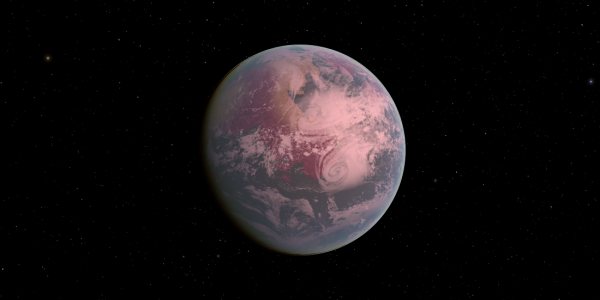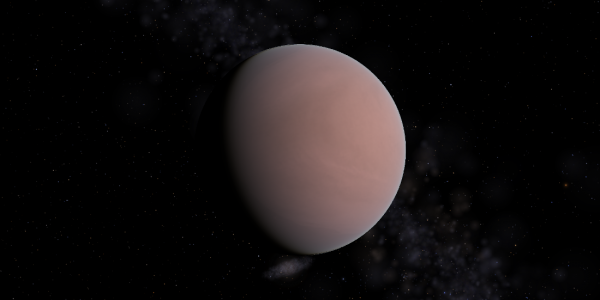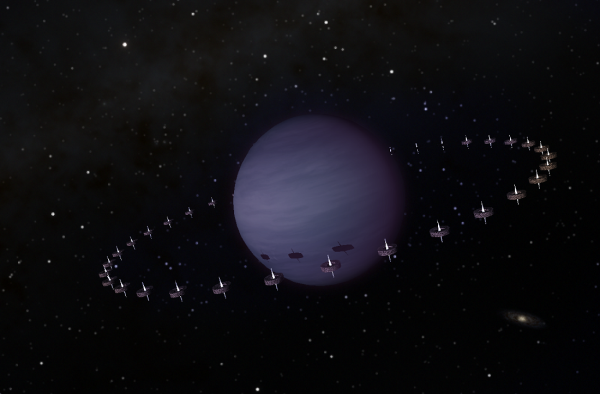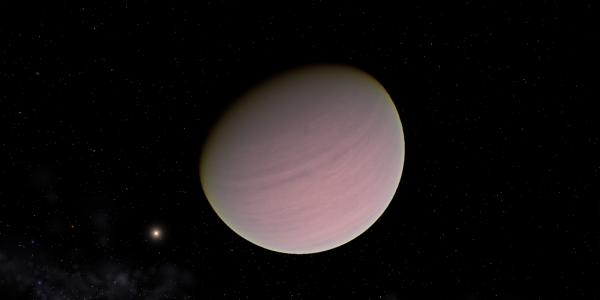BY LETTER
Proxima Centauri (Alpha Centauri C)
Galactography > Regions of Space > Inner Sphere
Galactography > Sephirotic Empires > Sophic League
Galactography > Systems and Worlds > Systems & Worlds O - P
Galactography > Sephirotic Empires > Sophic League
Galactography > Systems and Worlds > Systems & Worlds O - P
The closest star to Sol | |
.png) Image from Dangerous Safety | |
| The Proxima Centauri system; Lif, Lifthrasir, Ask, Embla, Skoll, Hati and Fenrir | |
Proxima System - Data Panel | |
| System | Names: Cenaurinume Components: 3 1) Rigil Kentaurus (Alpha Centauri A) 2) Toliman (Alpha Centauri B) 3) Proxima Centauri (Alpha Centauri C) Location: - Distance from Sol: 4.321 ly (J2000), 3.660 ly (10600 AT) - Constellation: Centaurus |
|---|---|
| Star | Names: Proxima Centauri (Proxima), Alpha Centauri C Orbital characteristics: - Separation from AB: 8,700 AU - Period: 547,000 Julian years - Eccentricity: 0.50 Physical characteristics: - Mass: 0.1221 x Sol - Radius: 0.1542 x Sol - Luminosity: 0.001834 x Sol (bolometric) - Temperature: 3,042 Kelvin - Spectral type: M5.5 Ve - Age: 4.85 billion years Distance from Sol: 4.244 ly (J2000), 3.555 ly (10600 AT) Polities: - Proxima Cenaurinume An ecology has been established in Proxima's atmosphere. These ultra-high temperature diamondoid lifeforms, which had been described by some Sephirotic observers as 'giant sun fullair monsters', are actually designed to stay aloft by a combination of buoyancy and manipulation of the star's magnetic fields. They derive energy by manipulating the magnetic field lines, preventing flares and CMEs as a side effect. Proxima is surrounded by a proto-dyson sphere known as the Core of Proxima, whose materials were derived from the inner belt and then Lif. Its construction had greatly slowed during the third millennium, only receiving a boost to restore elements that were damaged after the Third Nauri Dispute. It is too tenuous to block a significant amount of starlight. The Core contains the majority of the Nauri population. None of the computronium nodes in the Core were leased to the Sephirotic population, and all details about what exists inside it came from invited individuals or the Nauris who joined Sephirotic later on. |
 Image from The Astronomer | |
| Lif in the Current Era has been ecoformed to create a non-standard life-bearing environment | |
| Lif | Names: Lif, Proxima Centauri d (Proxima d) Orbital characteristics: - Semi-major axis: 0.029 AU - Orbital period: 5.15 days - Eccentricity: 0.038 Physical characteristics: - Type: Videntian HydroTerrestrial LapiMinervan EstuaTepidal AquaVitrioGaian - Mass: 3.688E+24 kg (0.618 Earths) - Radius: 5,518.7 km (0.866 Earths) - Density: 5,238 kg/m^3 - Mean surface acceleration: 8.082 m/s^2 (0.824 g) - Rotation period: Tidally-locked - Albedo: 0.432 - Average surface temperature: 337 K Atmosphere: - Surface pressure: 415.0 kPa - Composition: 93.9% nitrogen, 4.8% oxygen, 0.9% sulfur dioxide, 0.4% carbon dioxide, trace amounts of argon, water, hydrogen sulfide, and sulfur. Lagrangian points: L1: Lagrange Magshield L2: The Ring of Mirror of Questionable Quality L3: empty L4: Nauri computronium swarm L5: Nauri computronium swarm Polities: - Proxima Cenaurinume - 50 Sephirotic polities, all of them having some presence on the Ring of Mirror of Questionable Quality. Lif's transformation into a Vitriolic world concluded in 7988, giving it an ocean of sulfuric acid and water that spanned half of the planet's surface area. The designing of the planet's biosphere is an ongoing community project; all inhabitants of Lif are encouraged to participate in the project by designing a species per person. The result was described by the inhabitants and the visitors alike as a chaotic mix of almost every type of life possible - biological, mechanical, virtual, and anything in between, all with mutualism relationships and operating in harmony. Not all life on Lif was created this way; some can be traced back to the gardens created during the fourth millennium. Lif is surrounded by two orbital rings. The smaller and the older one was constructed during the Version War for housing the refugees heading to Lif, many of whom had settled on the ring even after the war. Another was built during the Central Alliance era by the Inner Sphere Development Alliance, and has several polities affiliated with the Terragen Federation in addition to orbital polities whose habitats were disassembled to make space for the ring. Its L1 has been continuously occupied by the magshield since the Age of Expansion, while the Ring of Mirror of Questionable Quality was constructed based on the proposal made by the refugees from the Luliwa system during the Version War. |
|---|
 Image from The Astronomer | |
| Lifthrasir | |
| Lifthrasir | Names: Lifthrasir, Proxima Centauri b (Proxima b) Orbital characteristics: - Semi-major axis: 0.0485 AU - Orbital period: 11.186 days - Eccentricity: 0.105 Physical characteristics: - Type: Videntian HydroTerrestrial CereMinervan InuThermal AquaGaian AquaThalassic - Mass: 1.492E+25 kg - Radius: 9,008.2 km - Density: 4,873 kg/m^3 - Mean surface acceleration: 12.273 m/s^2 (1.251 g) - Rotation period: Tidally-locked - Albedo: 0.684 - Average surface temperature: 616 K Atmosphere: - Surface pressure: 13.8 MPa - Composition: 59.2% carbon dioxide, 20.4% water, 12.9% oxygen, 7.3% nitrogen, 0.1% hydrogen, trace amounts of sulfur dioxide, methane, argon, and helium. Lagrangian points: L1: The Blob, a mysterious singular Nauri structure of unknown purpose whose shape is constantly changing. It is guarded by a restriction swarm that prevents Sephirotic settlement of the area. L2: The Will of the Golden Sisters, a swarm of tens of thousands of rotahabs, each containing experimental Cytherean ecosystems. Most of them are inhabited by Venusian tweaks. L3: empty L4: Nauri computronium swarm L5: Nauri computronium swarm Polities: - Proxima Cenaurinume - 24 Sephirotic polities, dominated by House Mey Auralai, a direct descendant of the Sorority of the Gardeners of the Golden Worlds. Lifthrasir is home to the largest population of Venusian tweaks in the Proxima system, owing to the abundance of Venus-like environments in its habitats, a result of the influence of the pro-Venusian House Mey Auralai. The planet's ocean is home to a large number of traveling conversion-fusion generator swarms producing energy to fuel deep sea life as they migrate across the ocean. Many life and habitats alike follow these generator swarms, forming 'caravans of light' consisting of the light and the 'follower of light'. Others were designed to only become active when activated by light, hibernating during the 'winter'. The surface of the ocean has been partially colonized by giant mats of microorganisms that feeds on nutrients falling from the upper atmosphere ecosystems and in the water, and in turn serving as a food source for other marine life. The Sorority of the Gardeners of the Golden Worlds and its successor, House Mey Aurulai, constructed and maintained a large number of Cytherean habitats surrounding Lifthrasir as well as at L2, where they are collectively referred to as the Will of the Golden Sisters. The Will serves as the Sorority and the House's biosphere test tubes, but many are open for habitation as well, while the habitats surrounding the planet itself were constructed to accommodate several waves of Venusian tweaks from Sol, thus they often rather faithfully replicate Venus' environments. The L1 point is occupied by the Blob, a mysterious Nauri construct that appeared just after the Third Nauri Dispute. |
|---|---|
| Ask | Name: Ask Orbital characteristics: - Semi-major axis: 0.097 AU - Orbital period: 31.725 days - Eccentricity: 0.13 Physical characteristics: - Type: Stilbonian CereRhean Tundral CapnoArean AquaGanymedean - Mass: 6.534E+24 kg - Radius: 7,162.6 km - Density: 4,245 kg/m^3 - Mean surface acceleration: 8.500 m/s^2 (0.866 g) - Rotation period: 19.035 days (locked in a 3:5 spin-orbit resonance) - Solar day length: 47.587 days - Albedo: 0.221 - Average surface temperature: 187 K Atmosphere: - Surface pressure: 66.4 kPa - Composition: 97.8% nitrogen, 1.6% carbon dioxide (vapor), 0.4% argon, 0.2% carbon monoxide, and trace amounts of methane, oxygen, neon, hydrogen, helium, and ammonia (vapor). Lagrangian points: all are occupied by swarms of Nauri structures Polities: - Proxima Cenaurinume |
| Embla | Name: Embla Orbital characteristics: - Semi-major axis: 0.322 AU - Orbital period: 190.989 days (0.523 Julian years) - Eccentricity: 0.00 Physical characteristics: - Type: TholiTerrestrial CereRhean ConleTepidal TitanoGaian AquaGanymedean - Mass: 8.692E+24 kg - Radius: 8,032.9 km - Density: 4,003 kg/m^3 - Mean surface acceleration: 8.990 m/s^2 (0.916 g) - Rotation period: 4.83 days - Solar day length: 4.96 days - Obliquity: 8.4° - Albedo: 0.394 - Average surface temperature: 115 K Atmosphere: - Surface pressure: 855 MPa - Composition: 98.2% nitrogen (vapor), 1.2% methane (vapor), 0.5% hydrogen, 0.1% argon (vapor), and trace amounts of carbon monoxide (vapor), neon, helium, and ammonia (vapor). Lagrangian points: all are occupied by swarms of Nauri structures Polities: - Proxima Cenaurinume Both Ask and Embla were never made accessible to the non-Nauris. Their outward appearances do not appear to change significantly even after all the presumed developments that took place on both worlds, and minimal signs of civilization exist on their surfaces. |
 Image from Steve Bowers | |
| Skoll and the Enlightenment Band | |
| Skoll | Names: Skoll, Proxima Centauri c (Proxima c) Orbital characteristics: - Semi-major axis: 1.489 AU - Orbital period: 5.199 Julian years - Eccentricity: 0.005 Physical characteristics: - Type: CryoazuriNeptunian GeliJotunnian AquaMuspellian - Mass: 7.251E+25 kg - Radius: 23,775.7 km - Density: 1,288 kg/m^3 - Mean surface acceleration: 8.561 m/s^2 (0.873 g) - Rotation period: 18.132 hr - Obliquity: 64.9° - Albedo: 0.310 - Average surface temperature (1 bar): 56 K Satellites: 4 Apnean, 17 asteroidal Polities: - Proxima Cenaurinume - 463 Sephirotic polities, the most populous being the Enlightenment Bracelet, distantly followed by the Boostbeam Pagoda Theocracy. By the 84th century, much of the mass surrounding Skoll had been converted into the Enlightenment Bracelet, a long row of Bishop rings in the Clarke orbit, illuminated by luminaires attached to a 'ladder' structure. Each and every of the rings are governed by a group of transapients who occasionally incite trouble and create mysteries for its modosophont population to solve. The Enlightenment Bracelet hosted over 90% of Skoll's permanent population, while the majority of the rest inhabited a mid-size icy moon in a distant orbit, where the old Nauri facilities had been upgraded and decorated. These decorated pagoda-shaped boostbeam stations are an icon of the polity which governed over this moon, the Boostbeam Pagoda Theocracy. |
|---|
 Image from The Astronomer | |
| Hati (before construction of the supraplanetary structure) | |
| Hati | Name: Hati Orbital characteristics: - Semi-major axis: 3.636 AU - Orbital period: 19.837 Julian years - Eccentricity: 0.006 Physical characteristics: - Type: CryoazuriNeptunian GeliJotunnian AquaMuspellian - Mass: 1.144E+26 kg - Radius: 27,446.5 km - Density: 1,321 kg/m^3 - Mean surface acceleration: 10.135 m/s^2 (1.033 g) - Rotation period: 23.805 hr - Obliquity: 27.6° - Albedo: 0.299 - Average surface temperature (1 bar): 53 K Satellites: none Polities: - Proxima Cenaurinume - 826 Sephirotic polities, including the Outer Ring Confederation and the Eduu Jötunn Association. Since 6639, Hati's depth has been home to the system's overseer transapient, the Forgotten Wheel, and eir fellow S2s, who forbid modosophonts and S1s from colonizing regions below 1,000 bar. Its three icy satellites were disassembled for materials used to construct several layers of low temperature supraplanetary shells that completely envelop the planet. These shells are inhabited by hundreds of polities, many of whom were former occupants of the disassembled moons. Nearly all of these polities participate in a game where representatives are dropped in the lowest level of the shells and are tasked with the search for 'keys' required to ascend to the next level. The Hati environs are dominated by its rings, the only remaining object around the planet which was not removed during the construction of the supraplanetary shells due to local opposition. Inhabitants include the Outer Ring Confederation, the Eduu Jötunn Association, and one of the two major populations affiliated with the Proxima Maid Commune. The rings have also been colonized by several spaceborne ecosystems with different dominant colors arranged to produce a gradient which resembles Proxima's spectrum when seen in near infrared wavelengths where the small star's light peaks. |
|---|
 Image from The Astronomer | |
| Fenrir | |
| Fenrir | Name: Fenrir Orbital characteristics: - Semi-major axis: 6.674 AU - Orbital period: 49.334 Julian years - Eccentricity: 0.011 Physical characteristics: - Type: NeonoNeptunian GeliJotunnian AquaMuspellian - Mass: 8.560E+25 kg - Radius: 25,377.1 km - Density: 1,250 kg/m^3 - Mean surface acceleration: 8.871 m/s^2 (0.904 g) - Rotation period: 13.615 hr - Obliquity: 10.3° - Albedo: 0.620 - Average surface temperature (1 bar): 37 K Satellites: 6 Apnean, 19 asteroidal Polities: - Proxima Cenaurinume - 135 Sephirotic polities, including the Fomac-aligned Fenrir Living Museum and the Alambrac Nations. Planetary Fenrir is currently administered by the Neoncloud Cabinet, a transapient entity believed to be affiliated with the Fomalhaut Acquisition Society, which, in order to preserve the pristine planetary environment and the cultures, strictly controls activities on the planet and its environs. Still, the modosophont cultures thrived. One of the more notable cultures are the Alambrac Nations, a collection of some 478 habitats populated by a group of people known as the Alambracians, both original and enthusiasts, whose habitats organize a war game whose themes are based on fiction stories written by Alambracian writers - famous or obscure - every local year. |
|---|---|
| The Outer Belt | Radii: - Main radius: 30 AU - Inner radius: 25 AU - Outer radius: 35 AU Total mass: 7.943E22 kg Notable objects: Anitya, Anatta Polities: - Proxima Cenaurinume - 1,458 Sephirotic polities spreading across 155,464 habitats, with major habitat concentrations at 148 locations such as the Hi'ts'wii'nnik habitat cluster and the dwarf planet Anitya. - 152 other polities, including ahuman clusters and a few Deeper Covenant nations. The outer Proxima belt contained many ancient habitats such as the first Sephirotic habitats built by the crew of the Great Circle and the Boddhichittamaittreya habitat still in place, in addition to Nauri structures, both old and new. Most asteroids in this belt had been disassembled or reconstructed to create habitats and other structures. Several planetoids were also transformed in some way. For example, Anatta was, by the 41th century, partially converted into a cloud of Bishop rings orbiting around the remaining core. |
See also: The History of the Proxima System
Related Articles
Appears in Topics
Development Notes
Text by Updated by The Astronomer with contributions by Dangerous Safety and Ryan B (Rynn) (2021)
from an original article by M. Alan Kazlev and John M. Dollan
Initially published on 18 November 2010.
Data panel format update (2022-02-20, by The Astronomer)
from an original article by M. Alan Kazlev and John M. Dollan
Initially published on 18 November 2010.
Data panel format update (2022-02-20, by The Astronomer)
Additional Information
Records found at Vinci make mentions of an Exa Energy project to Proxima Centauri, apparently to construct habitats for humans. No such probe could be found either within the Proxima system or in the interstellar space beyond, and neither the Nauri nor the Great Circle colonists report a foreign probe of the sort.






